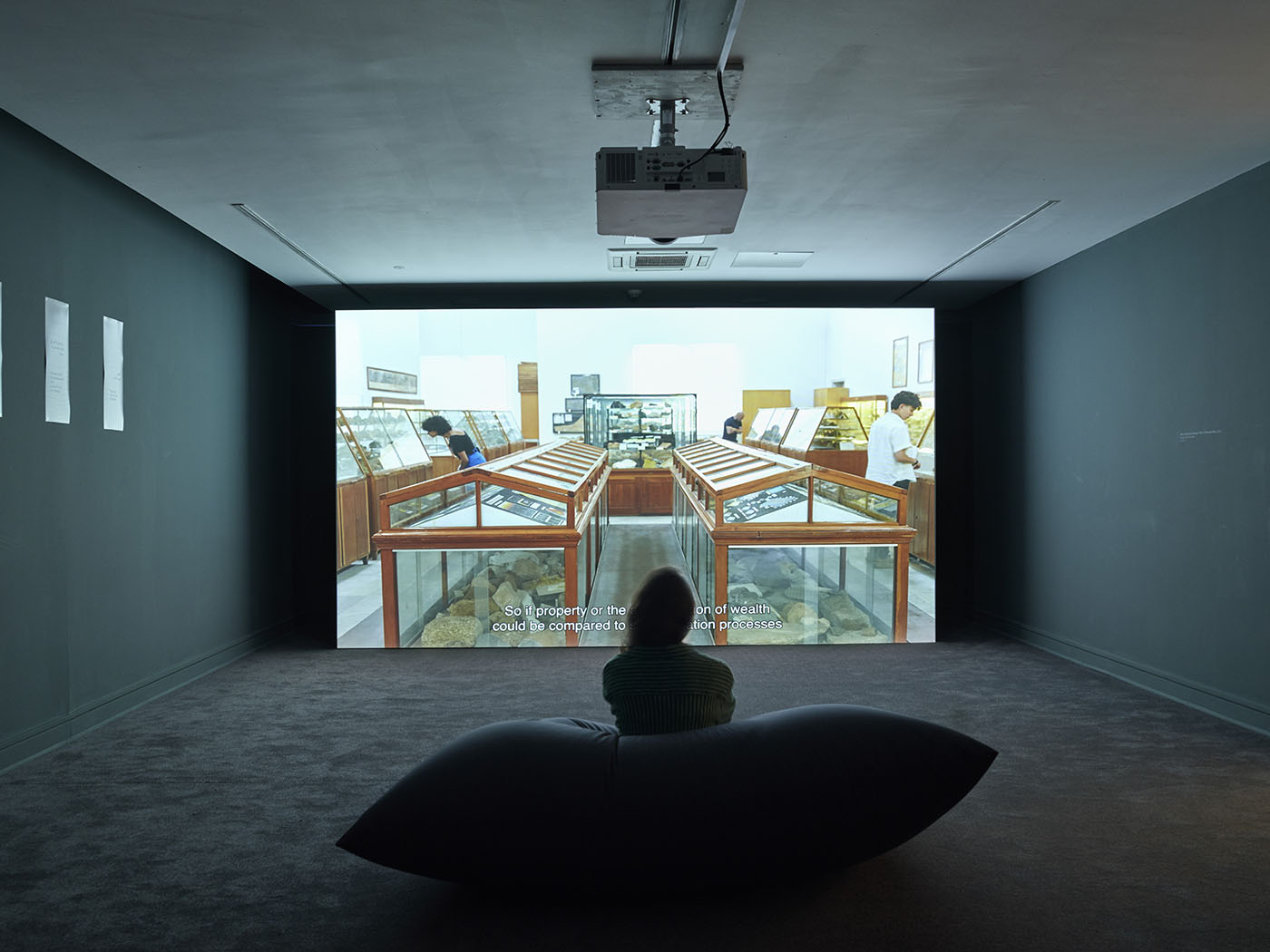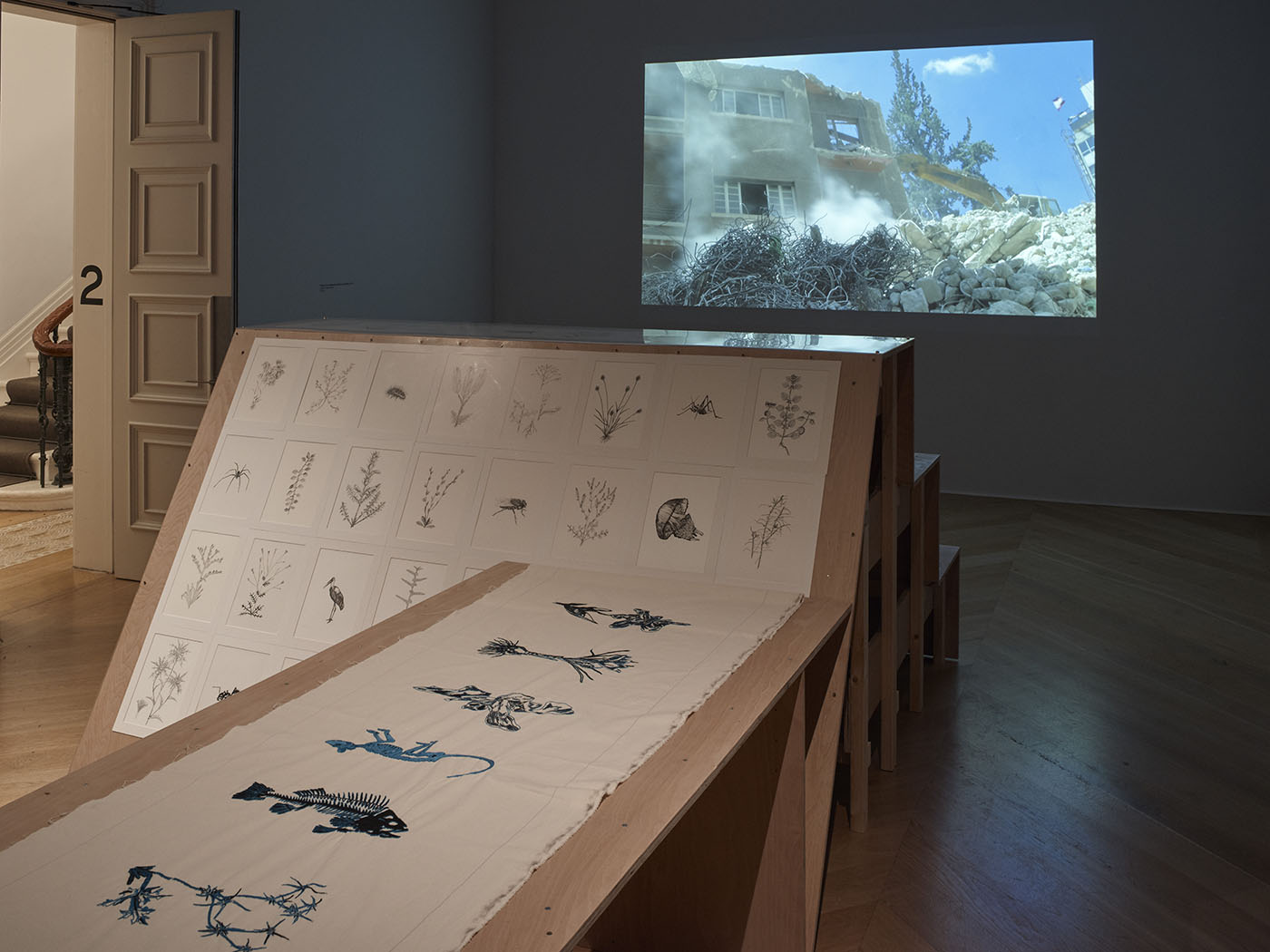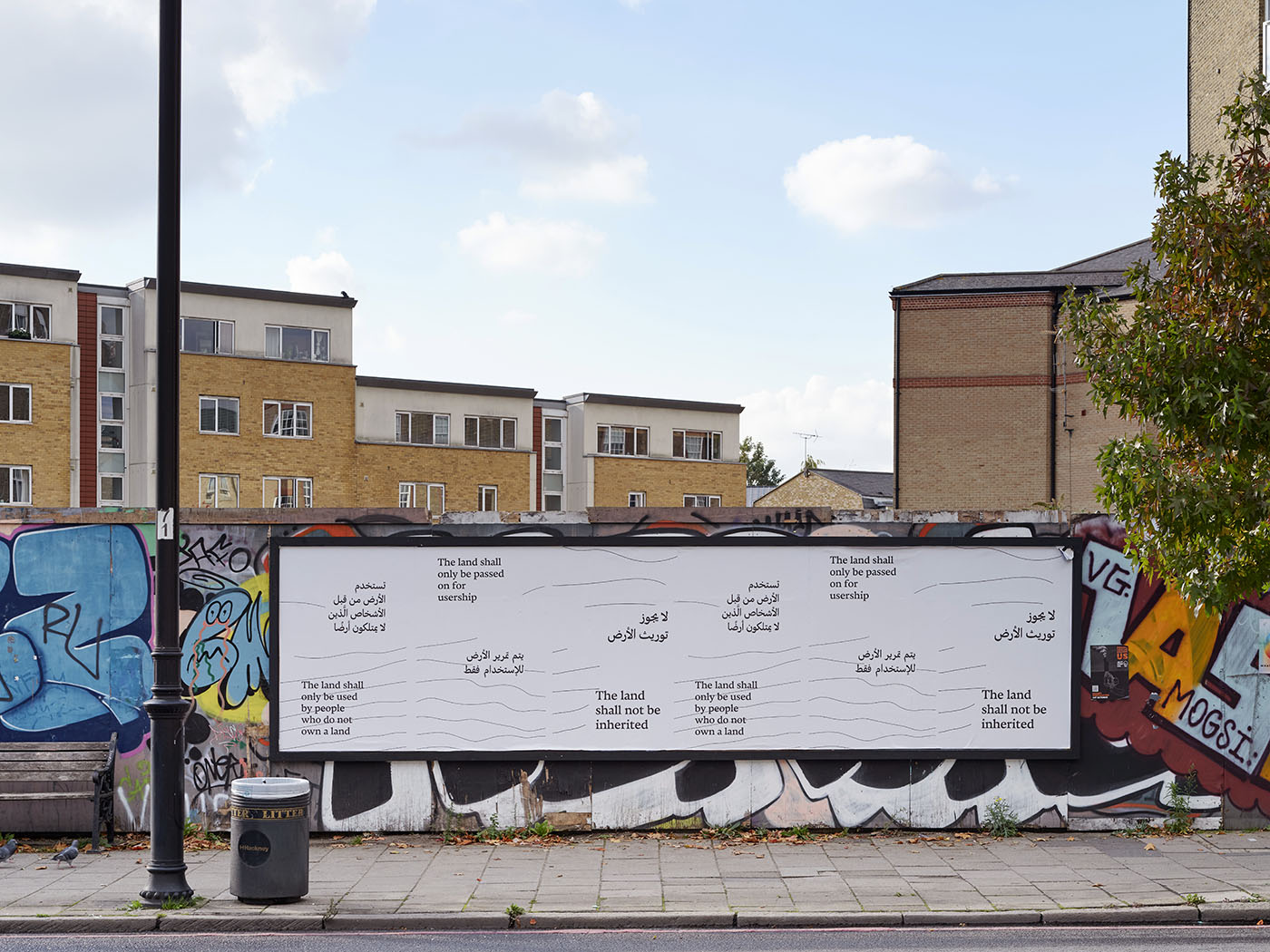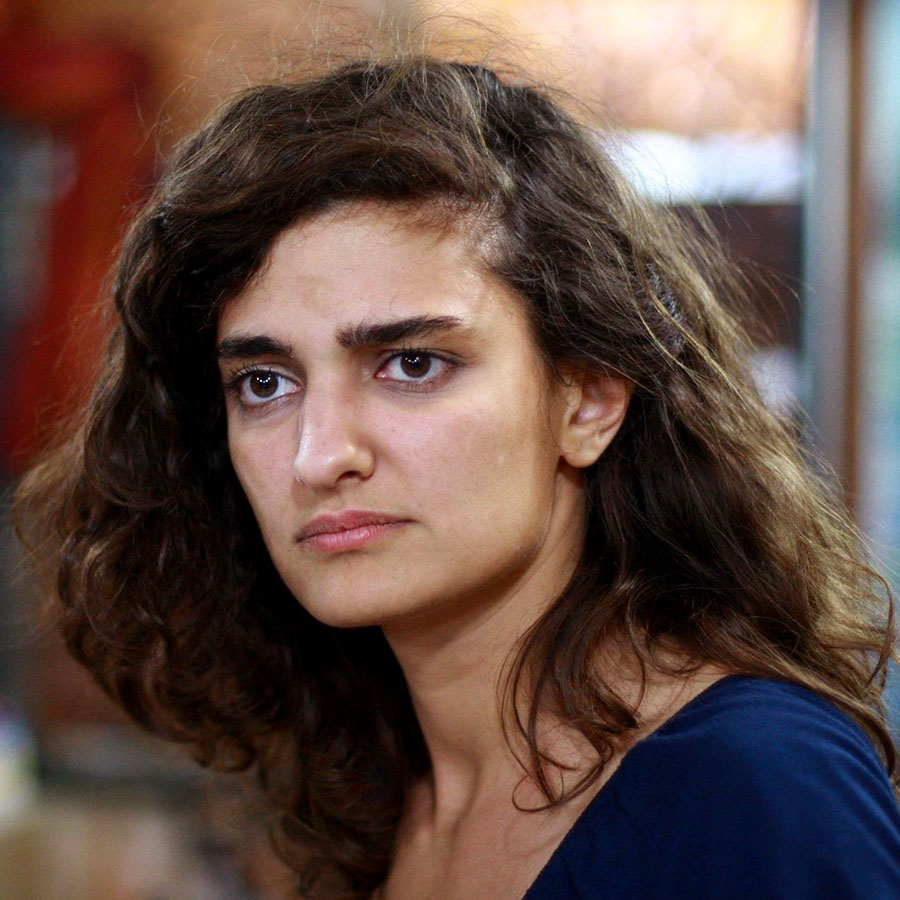
“Reverse Shot,” solo exhibition by Marwa Arsanios
The Mosaic Rooms, Tower House, 226 Cromwell Road, London SW5 0SW
Through Jan. 22, 2023
Mariam Elnozahy
“Reverse Shot,” on at the Mosaic Rooms through the 22nd of January, 2023, is Marwa Arsanios’ debut London solo exhibition. The first room in the exhibition presents the public with a syllabus in political ecology, a field which positions itself at the intersection of economics, nature, culture, and society. The books on display include theoretical texts such as The Dialectics of Nature by Fredrich Engels and The Three Ecologies by Felix Guattari which set up the ontological framework of the exhibition, and historically rooted case studies such as The Animal in Ottoman Egypt and The Arab Lands under Ottoman Rule, which bring those theoretical frameworks to use in a praxis. This room, wherein exhibition-goers can sit to read or skim the artist’s selection of texts, sets up the exhibition as a proposition for our shared future, one that tackles questions such as: how will we reconfigure our relationship to land, our relationship to labor, our relationship to history? “Reverse Shot” answers these questions in a way that is carefully calculated, historically rooted, and committed to political action.

The first film in the exhibition brings us back to Beirut in 2016, a time when investors and speculators were rapidly increasing land value through population displacement and ecocide, among other tactics. In a city that was nearly razed in a matter of minutes as a result of the August 2020 Beirut Port Explosion, it is difficult to identify the decimation of Beirut’s urban fabric as a long, systematic, and historical process. No doubt, events such as the port explosion are a catalyst towards the desolate condition that Lebanon is in today. But there are many significant historical factors that have made Beirut unlivable. One of the most prominent of these factors is the large-scale real estate development boom that has engulfed Beirut since the aftermath of the civil war, which ended in 1990, when the city underwent a neoliberal restructuring. This land-grabbing development scheme is the subject of the first film shown in the exhibition, Falling is not Collapsing Falling is Extending (2016).
The work hones in on the financialization of Beirut’s urban spaces by focusing on a specific site, the Karantina Garbage Dump, a mountain of rubble in the Medawar quarter, near Beirut’s port. The 2020 explosion was devastating for the Karantina neighborhood, which was primarily inhabited by members of a lower socio-economic class, but even before that, the area suffered from rampant exploitation and unjust practices. Arsanios first introduces us to Karantina through a view of the canal that opens to the sea, flanked by trees and shrubs. The first sequence presents a perfectly bucolic scene, only slightly disturbed by a faint mirage of a city in the distance. A meditation on this picturesque moment quickly transitions to a view of the Karantina garbage site, which, after its closure in 1997, was repurposed as a recreational zone for people in the neighborhood. Close ups reveal how the debris had been integrated into the land; the tires, plastic bags, and other rubbish had become subsumed by their surroundings and look more like archeological artifacts than modern waste. A wider shot shows how the garbage dump resembles a small mountain, built from layers of garbage sediment yet overgrown by shrubs and organisms that have found ways to make this toxic site habitable.

This kind of habitational recuperation bleeds out of the film into a wooden installation that somehow mirrors the Karantina garbage mountain: a slanted structure opposite the video showcasing four layers of drawings entitled “Resilient Weeds,” each representing an organism that is able to exist in toxic environments such as Karantina’s. The drawings continue into a long textile work, wherein more organisms, this time, representing snapshots of village life in Northern Syria, are embroidered into the fabric by a group of local craftswomen from the Sama Organization. Here, the women who come from the village of Jinwar, work with the artist to turn their memories of the natural environment that surrounds them into designs that are then reconfigured in the textile. Though the textile is from a different work to “Resilient Weeds,” the concept can be extended as a metaphor, wherein the resilient weeds are the laborers themselves, whose handcraft labor is sustained despite disappearing landscapes and toxic conditions.
The textile introduces another prominent line of inquiry present in the exhibition, one of labor and labor conditions, carried out by the video installation entitled “Amateurs, Stars, and Extras or the Labor of Love” (2012, 2018), the last work shown in this room. The video jumps between a film set in Lebanon and a fancy villa in Mexico City, both manicured sites which are disrupted by conversations with extras, in the former, and members of the domestic worker’s syndicate, in the latter. The conversations revolve around the cost of labor and the reproduction of labor, specifically by domestic workers who feel no sense of ownership over their work or the spaces they care for. The film is able to shed light on the invisibility of the labor of domestic workers, who are noticed only in their absence, when things become unkempt, and of extras, whose long days of waiting and silence backstage are essential to producing a clean final cut. Interviews with domestic workers illustrate how this invisibility is manipulated, resulting in laborers who are not recognized for their work, which is unregulated. One woman poses the question: who cares for the carers?

This is the question that leads us into the final video work, the fourth part of the artist’s “Who is Afraid of Ideology” series entitled “Reverse Shot, (2022)” exhibited in the bottom level of the gallery in a cinematically darkened room. Only when the film is bright do we see the writings on a series of posters on the wall, which together form a manifesto entitled “Chart for the usership of the land (2022).” The work follows an experiment conducted by the artist and a group of collaborators in North Lebanon, who are attempting to deprivatize an allotment of land and turn it into a social foundation (waqf) or a public domain (masha’a). The artist goes into Ottoman archives to dig into the history of the designation, and formulate an argument for the redesignation of the land, which would promote it for usership by people who do not own a land, who would cultivate it solely for agricultural purposes. She also interviews an old inhabitant of the area, who tells an oral history of informal land ownership systems that pre-date the land registrar’s establishment during the French mandate. The artist asks the old man how the land was divided, a question which, to him, seemed so intuitive that it was almost misunderstood. His answer was simple: “The land was divided according to who was using it.”
Later in the film, the old man elaborates that the people who worked hard to make a tiny bit of land cultivable for their survival were attached to it. He uses an Arabic phrase that literally means: “The land lived the people,” which would translate to “the people lived off of the land.” The subject-object tension between the land perspective and human perspective is constantly reiterated throughout the film, both aesthetically and in the voiceover dialogue. Can land provide without people? Can land have desires and demands? Aesthetically, the artist uses devices such as animation or camera perspectives that defy human-eye-level to try to inhabit the perspective of the land. Despite the limitations to inhabiting non-human perspectives — one of the interlocutors asks, “If property is the representation of land, how would we film it without owning it?” — the artist nevertheless takes on the challenge. To do so, she relies on filmic devices to try to represent the epistemological shift necessary in reformulating an understanding of the Earth as agentive, kinetic, and able to articulate its own needs and desires. A key example is when a shot of the quarry in the mountain surrounding the land in question yields to an animation in which rocks dance while an audio describes how property accumulation is shaken by tectonic movements or earthquakes. Here, the artist is able to approach a non-human perspective in order to convey how and when the land is able to articulate its desire that it does not want to be owned.
Who cares for the carers? The land cares for us, and we care for the land, but how do we regulate this relationship in a modern framework wherein care and cultivation often slip into unregulated labor and exploitation? The artist turns to the only mechanisms at our disposal, as humans: political, legal, or religious mechanisms to restructure the relationship between ourselves and the land. These mechanisms are outlined in the manifesto accompanying the video, which states codes ranging from those as simple as “The land shall not be inherited” and “The land shall not be built” to “The land shall only be tended following permaculture processes” and “The surplus produce can be sold and the benefits divided between users.” The manifesto presents a political vision that attempts to restructure social, economic, and power relations. While it is not perfect — my mother, who attended the exhibition with me, asked why would the artist go through all this trouble to create all these rules and designate the plot of land as a masha’a if it was not going to be inherited — it is a powerful (unafraid) consequence of the ideologies Arsanios has synthesized in the works present in the exhibition.
In film, reverse shot is a technique that presents two angles: an action and a reaction. Typically, filmmakers use this to shoot dialogue between two characters, who, though present in the same scene, are filmed separately using different camera angles. As film viewers, we are often placed in the position of one of the actors, facing the other head on, either provoking a response or awaiting an answer. We are forced into a perspective that allows us to feel a once-distant tension intimately, and maybe even, to think about what our response would be were we in this position. In the exhibition, viewers are made to experience the same shift in perspective. The artist presents a series of happenings and asks: if you were in this position, what would you do? If this happened in front of you, how would you react?



